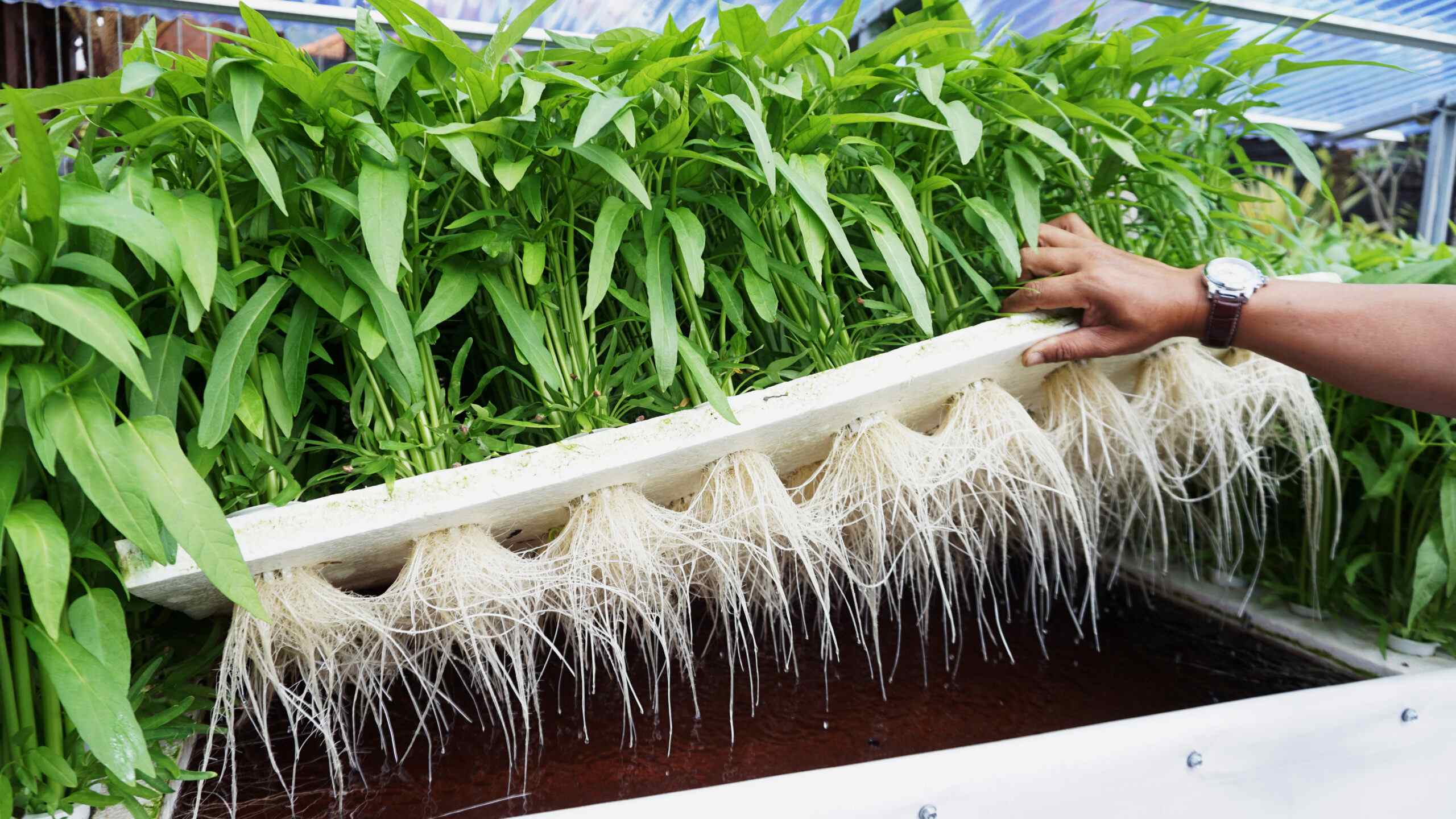Home>Gardening News and Trends>What Would Happen If A Farmer Used Too Much Fertilizer?


Gardening News and Trends
What Would Happen If A Farmer Used Too Much Fertilizer?
Modified: January 22, 2024
Discover the potential consequences of excessive fertilizer usage on crops and the environment. Stay informed with the latest news on farming practices.
(Many of the links in this article redirect to a specific reviewed product. Your purchase of these products through affiliate links helps to generate commission for Chicagolandgardening.com, at no extra cost. Learn more)
Table of Contents
Introduction
Fertilizers play a crucial role in modern agriculture, providing essential nutrients to plants and boosting crop yields. Farmers rely on fertilizers to ensure the healthy growth and development of their crops, ultimately contributing to global food security. However, like any agricultural practice, the excessive or improper use of fertilizers can have detrimental effects on the environment, human health, and even the economy.
When farmers use too much fertilizer, it can lead to a range of negative consequences. The excess nutrients can contaminate water sources, disrupt ecosystems, degrade soil quality, and pose risks to human and animal populations. Furthermore, the economic implications for farmers, such as increased costs and diminished crop quality and yield, are also significant.
In this article, we will explore the effects of excessive fertilizer use, including its environmental impacts and economic consequences. We will also discuss regulatory measures and best practices that can help mitigate these issues. By understanding the potential harms and adopting responsible fertilizer management techniques, farmers can strike a balance between optimizing crop production and safeguarding the environment.
It is crucial to address the issue of excessive fertilizer use to sustainably support agricultural practices worldwide. By examining the various effects and exploring potential solutions, we can work towards creating a more environmentally conscious and economically viable future for agriculture.
Effects of Excessive Fertilizer Use
While fertilizers are essential for providing plants with the necessary nutrients, using too much of them can result in a range of negative effects. Let’s explore some of the key impacts of excessive fertilizer use:
- Environmental Impacts: One of the primary concerns of excessive fertilizer use is its impact on the environment. When excess fertilizers are applied to fields, they can leach into nearby water sources, leading to water pollution and ecosystem disruption.
- Groundwater Contamination: The excessive use of fertilizers can result in the contamination of groundwater with nitrates and phosphates. These nutrients can remain in the water supply, posing a risk to human health and contributing to the development of various health issues.
- Algal Blooms: When fertilizers enter water bodies such as lakes and rivers, they can lead to the growth of excessive algae. This phenomenon, known as algal blooms, depletes oxygen levels in the water, harming aquatic life and creating dead zones.
- Soil Degradation: Excessive use of fertilizers can lead to soil degradation. When excessive nutrients accumulate in the soil, it can alter the soil’s pH levels, disrupt beneficial microbial communities, and reduce soil fertility. This can result in decreasing crop yields over time.
- Decreased Biodiversity: The improper use of fertilizers can negatively impact biodiversity. The excessive nutrients can encourage the growth of weeds, reducing the diversity of plant species. Additionally, the runoff of fertilizers can harm beneficial insects and microorganisms, disrupting natural ecosystems.
These effects of excessive fertilizer use highlight the importance of implementing responsible fertilization practices. By carefully managing fertilizer application rates and adopting precision farming techniques, farmers can minimize adverse impacts on the environment while maximizing crop productivity.
Environmental Impacts
The environmental impacts of excessive fertilizer use are significant and can have far-reaching consequences. Let’s delve deeper into some of the key environmental effects:
- Water Pollution: Excessive application of fertilizers can result in water pollution. When rainfall or irrigation water carries the excess nutrients from fields into water bodies, such as rivers and lakes, it can lead to an overabundance of nutrients, particularly nitrogen and phosphorus. This nutrient-rich water can cause eutrophication, where algal growth becomes excessive and disrupts aquatic ecosystems.
- Loss of Aquatic Life: The excessive growth of algae due to nutrient runoff can deplete dissolved oxygen levels in water bodies. This oxygen depletion can suffocate fish and other aquatic organisms, leading to fish kills and a decline in biodiversity. The loss of aquatic life disrupts the delicate balance of ecosystems, affecting the entire food chain.
- Disruption of Soil Ecology: Excessive fertilization can alter the composition and activities of soil microorganisms. These microorganisms play a vital role in maintaining soil health, nutrient cycling, and organic matter decomposition. When the balance of soil ecosystems is disrupted, it can lead to a decline in soil fertility, reduced nutrient absorption by plants, and ultimately lower crop yields.
- Harm to Beneficial Insects and Pollinators: The runoff of excess fertilizers can harm beneficial insects and pollinators that are essential for the health of ecosystems and crop production. Bees, butterflies, and other pollinators can be negatively impacted by the chemicals present in fertilizers. Furthermore, the decline in these pollinators can result in reduced plant diversity and food chain disruption.
- Carbon Footprint: The production and use of fertilizers contribute to greenhouse gas emissions, including carbon dioxide (CO2) and nitrous oxide (N2O). The manufacturing process of synthetic fertilizers releases CO2, while nitrous oxide is released when nitrogen-based fertilizers are applied to fields. These greenhouse gases contribute to climate change and its associated environmental impacts.
Understanding the environmental impacts of excessive fertilizer use is crucial for implementing effective measures to reduce harm. Proper fertilization management techniques, such as soil testing, precision application methods, and the use of organic alternatives, can help mitigate these effects and promote sustainable agricultural practices.
Groundwater Contamination
Excessive fertilizer use poses a significant risk of groundwater contamination. Groundwater, which serves as a vital source of drinking water for many communities, can become contaminated when excess nutrients from fertilizers infiltrate the soil and seep into the groundwater system. Let’s explore the implications of groundwater contamination due to excessive fertilizer use:
Nitrate and Phosphate Contamination: Nitrogen-based fertilizers, such as ammonium nitrate, and phosphate-containing fertilizers are the primary culprits of groundwater contamination. These fertilizers contain high levels of nitrate and phosphate, which are highly soluble in water. When excessive quantities of these nutrients are applied to fields, they can easily leach through the soil, reaching and contaminating groundwater sources.
Health Risks: Elevated nitrate levels in drinking water can pose serious health risks, particularly for infants and pregnant women. Consumption of nitrate-contaminated water can lead to a condition called methemoglobinemia, also known as blue baby syndrome, which impairs the blood’s ability to carry oxygen. High levels of nitrate in drinking water have also been linked to various health issues, such as increased risk of certain cancers and thyroid problems.
Agricultural Runoff: Agricultural runoff is a significant contributor to groundwater contamination. When excessive rainfall or irrigation occurs, fertilizers that have not been taken up by plants or absorbed by the soil can be carried off the fields, entering nearby water bodies or infiltrating the groundwater table. This runoff usually occurs in areas with poor drainage or when fertilizers are applied before heavy rain events.
Leaching Potential: The leaching potential of nitrate and phosphate depends on various factors, including soil type, climate, irrigation practices, and fertilizer application methods. Sandy soils with low cation exchange capacity are more prone to nutrient leaching, while heavy rainfall or over-irrigation can further increase the risk. Additionally, improper timing and application rates can result in excess nutrients that are not taken up by plants, increasing the likelihood of leaching into groundwater sources.
Prevention and Mitigation: Preventing groundwater contamination requires a multifaceted approach. Implementing best management practices, such as soil testing, proper nutrient management planning, and precision application techniques, can help minimize the risk of excessive nutrient leaching. Additionally, establishing buffer zones near water bodies can help trap and filter any runoff that may occur.
Awareness and education initiatives are also crucial to inform farmers about the potential risks of groundwater contamination and the proper handling and application of fertilizers. By adopting proactive and responsible fertilizer management practices, farmers can play a vital role in safeguarding groundwater resources and protecting public health.
Algal Blooms
Excessive fertilizer use can contribute to the occurrence of algal blooms, a phenomenon characterized by the rapid and excessive growth of algae in aquatic environments. This can have severe implications for both aquatic ecosystems and human health. Let’s examine the key aspects and impacts of algal blooms:
Nutrient Enrichment: Algal blooms are primarily fueled by the excess nutrients, particularly nitrogen and phosphorus, found in fertilizers. When these nutrients enter water bodies through runoff or direct disposal, they act as a fertilizer for algae, triggering their rapid growth. The surplus nutrients provide an abundance of food, allowing algae populations to multiply quickly.
Oxygen Depletion: As algal populations multiply, they can form dense mats or “blooms” on the water’s surface. As these algae die and decompose, the process consumes oxygen, depleting oxygen levels in the water. This oxygen depletion can have detrimental effects on other aquatic organisms, such as fish and invertebrates, leading to fish kills and a decline in biodiversity.
Toxin Production: Some species of algae have the capability to produce toxins, known as harmful algal blooms (HABs). These toxins can have detrimental effects on marine life and human health. When consumed by marine organisms, such as shellfish, these toxins can accumulate in their tissues, leading to seafood contamination. Consumption of contaminated seafood can result in serious health issues, such as shellfish poisoning and other related illnesses.
Ecosystem Disruption: Algal blooms can disrupt aquatic ecosystems by altering the balance of species and food webs. The excessive growth of algae can outcompete other aquatic plants for sunlight and nutrients, leading to a decline in plant diversity. This, in turn, impacts the availability of habitats and food sources for aquatic organisms, ultimately affecting the overall health and productivity of the ecosystem.
Dead Zones: Algal blooms can contribute to the formation of “dead zones” in water bodies, where oxygen levels become extremely low or depleted. The decrease in dissolved oxygen can be so severe that it cannot support aquatic life. Dead zones have been observed in coastal areas around the world, causing long-term damage to marine ecosystems and the fishing industry.
To mitigate the occurrence and impact of algal blooms, it is crucial to adopt responsible fertilization practices, such as precision application techniques and the use of slow-release or controlled-release fertilizers. Additionally, implementing measures to reduce nutrient runoff, such as establishing buffer zones and conservation practices, can help minimize the influx of excess nutrients into water bodies.
By recognizing the relationship between excessive fertilizer use and algal blooms, we can take proactive steps to protect aquatic ecosystems, preserve biodiversity, and ensure the safety of our water resources for present and future generations.
Soil Degradation
Excessive fertilizer use can lead to soil degradation, which encompasses a range of negative impacts on soil health and quality. Let’s explore the various ways in which excessive fertilization can contribute to soil degradation:
Nutrient Imbalance: When excessive amounts of fertilizers are applied to soil, it can disrupt the natural balance of essential nutrients. Over time, this imbalance can result in nutrient deficiencies or toxicities, impairing plant growth and reducing crop yields. The excessive accumulation of nutrients can also alter the soil’s pH levels, further impacting nutrient availability.
Soil Acidification: Certain fertilizers, such as ammonium-based fertilizers, can contribute to soil acidification. Overuse of such fertilizers increases the acidity of the soil, which can have detrimental effects on soil structure and microbial activity. Acidic soils are less favorable for plant growth, as they negatively impact nutrient uptake by plants and suppress beneficial soil organisms.
Loss of Organic Matter: Excessive fertilization can hinder the accumulation and decomposition of organic matter in the soil. Organic matter is essential for maintaining soil fertility, structure, and nutrient-holding capacity. When organic matter levels decline, soil quality diminishes, leading to reduced water infiltration, increased erosion risk, and decreased soil biodiversity.
Reduced Soil Microbial Activity: The excessive application of fertilizers can disrupt the microbial communities present in the soil. Beneficial soil microorganisms, such as bacteria and fungi, are vital for various soil processes, including nutrient cycling, organic matter decomposition, and disease suppression. Disrupting the activities of these microorganisms can lead to imbalances in nutrient availability and increased susceptibility to pests and diseases.
Erosion and Compaction: Excessive fertilization can contribute to soil erosion and compaction. When fertilizers are used in large quantities, they can increase the runoff risk during rainfall events, leading to soil erosion and loss of topsoil. Moreover, the repeated application of fertilizers without proper management practices can lead to soil compaction, which restricts root growth and the movement of air and water within the soil.
To mitigate soil degradation caused by excessive fertilizer use, there are several best practices that can be employed. These include adopting soil testing to determine nutrient requirements, practicing precision fertilization techniques, incorporating organic matter through cover cropping or compost application, and implementing sustainable soil management practices like crop rotation and conservation tillage.
By promoting responsible fertilizer application and soil management practices, we can help preserve soil quality, maintain long-term fertility, and ensure sustainable agricultural practices for future generations.
Decreased Biodiversity
Excessive fertilizer use can have detrimental effects on biodiversity, impacting the variety and abundance of plant and animal species within ecosystems. Here are some key considerations regarding the decreased biodiversity resulting from excessive fertilizer use:
Weed Encroachment: Excessive nutrient availability from fertilizers can promote the growth of weeds, which compete with desired plant species for resources such as water, sunlight, and nutrients. This competition can lead to a decrease in plant biodiversity as weeds outcompete and dominate other plant species, reducing the overall diversity of plants in an area.
Changes in Plant Species Composition: High nitrogen levels resulting from excessive fertilizer application can favor certain plant species over others, resulting in a shift in plant species composition. Nitrogen-loving plants, known as nitrophilic species, often thrive in areas with excessive nitrogen availability, while other plant species may struggle to compete. This can lead to a decline in the diversity of plant species within an ecosystem.
Impact on Insects and Pollinators: Excessive fertilizer use can negatively affect beneficial insects and pollinators. The overabundance of nutrients can alter flowering patterns and nectar production in plants, which can impact pollinators, including bees, butterflies, and other insects. This disruption in pollination can have cascading effects on plant reproduction and the overall biodiversity of an area.
Soil Microbial Communities: Excessive fertilizer application can also impact soil microbial communities, which play a vital role in soil health and nutrient cycling. Some microbial species may be more sensitive to changes in nutrient availability than others, leading to imbalances in soil microbial communities. This disruption can affect nutrient availability for plants and can have long-term consequences on soil health and the overall biodiversity of the ecosystem.
Loss of Habitat and Ecosystem Function: The cumulative effects of excessive fertilizer use can result in habitat degradation and fragmentation, as well as a loss of essential ecosystem functions. When plant diversity decreases, animal species that depend on specific plants for food or shelter may also suffer. This loss of habitat and disruption of ecosystem functions can have far-reaching consequences for the overall biodiversity and ecological balance of an area.
To mitigate the negative impacts of excessive fertilizer use on biodiversity, farmers and land managers can adopt practices that promote ecological balance. This includes reducing fertilizer application rates to match crop needs, implementing integrated pest management strategies to manage weeds and pests, and preserving natural habitats and ecosystems to support diverse plant and animal communities.
Protecting and promoting biodiversity is not only essential for maintaining the resilience and functionality of ecosystems, but also for sustaining food production, wildlife habitats, and overall ecosystem health.
Economic Consequences
The excessive use of fertilizers can have significant economic consequences for farmers and the agricultural industry as a whole. Let’s explore some of the key economic impacts of excessive fertilizer use:
Increased Costs for Farmers: Excessive fertilizer use can result in higher input costs for farmers. Applying more fertilizers than necessary not only leads to unnecessary expenses but also contributes to resource wastage. With rising fertilizer prices, excessive use can strain the financial viability of farming operations, especially for small-scale farmers.
Impact on Crop Quality and Yield: While fertilizers are meant to enhance crop growth and yield, excessive use can have the opposite effect. Overfertilization can lead to imbalances in nutrient availability, negatively impacting plant health and reducing crop quality. Moreover, excessive nutrient levels, particularly nitrogen, can result in lush vegetative growth at the expense of reproductive development, leading to lower yields.
Diminished Soil Fertility: Excessive fertilization can degrade soil fertility over time. As mentioned earlier, nutrient imbalances, soil acidification, and reduced organic matter content can impair soil health and nutrient availability. Consequently, farmers may need to invest more in soil amendments and corrective measures to restore soil fertility, which can further increase costs.
Environmental Compliance Costs: In some regions, excessive fertilizer use may lead to regulatory non-compliance and potential fines. Government bodies and environmental agencies may impose restrictions or regulations on fertilizer applications to safeguard water resources and ecosystems. Non-compliance can lead to legal consequences and additional costs for farmers who exceed regulated fertilizer usage limits.
Market Access and Consumer Demand: In today’s market, consumer demand for sustainably produced food is growing. Excessive fertilizer use may conflict with consumer expectations for environmentally friendly and responsibly produced agricultural products. Farmers who disregard sustainable practices may face challenges in accessing markets that require certifications or compliance with environmental standards.
Impact on Rural Communities: The economic consequences of excessive fertilizer use extend beyond individual farms. When soil health declines, crop productivity decreases, and economic stability in rural communities can be at risk. Decreased agricultural revenues can have a ripple effect on local businesses, including equipment suppliers, input providers, and other service industries that rely on a thriving agricultural sector.
To mitigate these economic consequences, education and awareness campaigns are essential to promote responsible fertilizer use. Implementing precision agriculture techniques, such as soil testing, targeted nutrient applications, and adopting sustainable soil management practices, can optimize fertilizer use, reduce input costs, and maintain crop quality and yield.
By adopting such practices, farmers can minimize economic risks, improve agricultural sustainability, and contribute to the long-term economic viability of the agricultural sector.
Increased Costs for Farmers
Excessive fertilizer use can have a significant impact on the financial well-being of farmers, resulting in increased costs that can strain the profitability of their operations. Here are some key factors contributing to the increased costs farmers may face:
Overapplication of Fertilizers: The primary driver of increased costs is the overapplication of fertilizers. When farmers use more fertilizers than necessary, they incur unnecessary expenses in purchasing and applying the excess nutrients. With rising fertilizer prices, this wasteful use of resources can lead to a significant increase in input costs.
Higher Fertilizer Prices: Fertilizer prices have been on the rise in recent years, partly due to increased demand and production costs. With excessive fertilizer use, farmers not only incur higher expenses due to overapplication but also face the challenge of navigating volatile and escalating fertilizer prices. This can further squeeze their profit margins and financial viability.
Diminished Cost Efficiency: Excessive fertilizer use can decrease the cost efficiency of farming operations. When farmers apply more nutrients than required, they are essentially wasting resources that could have been allocated elsewhere. This inefficiency reduces the overall return on investment and can hinder the financial success of the farm.
Environmental Compliance and Penalties: In some regions, excessive fertilizer use can lead to regulatory non-compliance and potential penalties. To protect water resources and ecosystems, governments and environmental agencies may establish regulations on fertilizer applications, including limits on the amount or timing of application. Failure to comply with these regulations can result in fines and additional costs for farmers.
Investment in Corrective Measures: Excessive fertilizer use can deplete soil fertility and degrade soil health. As a result, farmers may need to invest additional resources in soil amendments and corrective measures to restore soil fertility. These measures can include soil testing, application of specific nutrients, and adopting soil conservation practices. The costs associated with these corrective actions further add to the financial burden on farmers.
Profitability Challenges: Excessive fertilizer use can affect crop quality and yield, potentially reducing farmers’ profitability. Overfertilization can lead to imbalances in nutrient availability, causing negative impacts on plant health and yield potential. Consequently, farmers may experience lower revenues and increased costs without realizing the expected return on their investments.
To mitigate the increased costs resulting from excessive fertilizer use, farmers can adopt precision agriculture techniques. This includes conducting soil testing to determine nutrient requirements, implementing targeted nutrient applications based on crop needs, and adopting sustainable soil management practices. These practices optimize fertilizer use, reduce wastage, and help farmers achieve higher cost efficiency in their operations.
Through education and access to resources, farmers can make informed decisions and better manage their fertilizer use, leading to more sustainable and financially viable farming practices.
Impact on Crop Quality and Yield
Excessive fertilizer use can have significant consequences on the quality and yield of crops, ultimately affecting the overall productivity and profitability of farmers. Here are some key considerations regarding the impact of excessive fertilizer use on crop quality and yield:
Nutrient Imbalances: Applying excessive amounts of fertilizers can disrupt the balance of nutrients in the soil. While plants require a specific ratio of nutrients for optimal growth, overfertilization can lead to nutrient imbalances and deficiencies. Imbalances in nutrients like nitrogen, phosphorus, and potassium can negatively impact plant health, resulting in stunted growth, reduced vigor, and increased susceptibility to diseases and pests.
Imbalanced Vegetative Growth: Excessive nitrogen fertilization, in particular, can lead to uncontrolled vegetative growth at the expense of reproductive development. Plants may become excessively lush, with vigorous foliage but limited fruiting or flowering. This can result in reduced crop yields and a diluted concentration of nutrients in the harvested portion of the crop, affecting its quality and market value.
Nutrient Losses and Wastage: When excessive nutrients are applied, it can lead to leaching or runoff, especially in areas with poor drainage or heavy rainfall. Nutrients not taken up by plants can be lost, resulting in nutrient wastage and reduced efficiency of fertilizer use. This not only affects crop quality and yield but also represents a waste of resources and increased input costs for farmers.
Environmental Stress: Excessive fertilizer use can subject plants to environmental stress. High levels of nutrients can result in osmotic imbalances, affecting water uptake and causing physiological stress. This stress can manifest as leaf scorching, root damage, or other symptoms that negatively impact plant health and reduce crop productivity.
Environmental Sensitivity: Different crops have varying nutrient requirements, and excessive fertilization can have differing impacts on each crop. Some crops may be more sensitive to excess nutrients than others, leading to more pronounced negative effects on their growth and yield. It is crucial to carefully match fertilizer application rates with specific crop requirements to optimize productivity and minimize negative consequences.
To mitigate the impact of excessive fertilizer use on crop quality and yield, farmers can adopt precision fertilization practices. This includes conducting soil testing to understand nutrient availability, implementing targeted fertilization strategies based on crop needs, and regularly monitoring plant health to detect and address any nutrient deficiencies or imbalances.
By optimizing fertilizer use and ensuring the right balance of nutrients, farmers can promote healthy crop growth, enhance crop quality, maximize yields, and ultimately improve their overall financial returns.
Regulatory Measures and Best Practices
To address the issues associated with excessive fertilizer use, regulatory measures and best practices have been established to promote responsible fertilizer management. Let’s explore some of the key initiatives and strategies in place:
Regulatory Measures: Many countries and regions have implemented regulations and guidelines to govern fertilizer use. These measures often include limitations on the amount and timing of fertilizer applications to protect water resources and prevent environmental pollution. Compliance with these regulations is crucial to ensure sustainable fertilizer practices and minimize adverse effects on ecosystems and human health.
Soil Testing: Soil testing is a fundamental practice for farmers to assess the nutrient levels and requirements of their soil. It helps determine the specific fertilizer needs of crops, allowing farmers to apply fertilizers more precisely and tailor their application rates to match crop requirements. Regular soil testing improves nutrient management, minimizes overuse, and reduces the risk of environmental contamination.
Precision Agriculture Techniques: Precision agriculture techniques, including variable rate fertilization and site-specific nutrient management, help optimize fertilizer use. These approaches involve using advanced technologies, such as Geographic Information Systems (GIS) and Global Positioning Systems (GPS), to apply fertilizers only where they are needed most. By targeting fertilizer applications, farmers can achieve more efficient nutrient utilization and reduce the risk of nutrient leaching or runoff.
Sustainable Soil Management: Implementing soil conservation practices is vital for maintaining soil health and fertility. Techniques such as cover cropping, crop rotation, and conservation tillage help improve soil structure, increase organic matter content, and enhance nutrient cycling. By employing these practices, farmers can minimize the need for excessive fertilization, reduce soil erosion, and improve overall soil health and productivity.
Integrated Nutrient Management: Integrated Nutrient Management (INM) approaches promote a combination of organic and inorganic fertilizers to optimize nutrient supply to crops. By integrating organic sources, such as crop residues, compost, or manure, with synthetic fertilizers, farmers can reduce reliance on chemical fertilizers, enhance soil fertility, and promote sustainable nutrient cycling. INM practices also help minimize nutrient losses and improve the efficiency of nutrient uptake by crops.
Education and Extension Services: Education and extension programs play a crucial role in promoting best practices among farmers. These initiatives provide access to information, training, and resources to raise awareness about responsible fertilizer use. By educating farmers about the potential impacts of excessive fertilizer use and providing guidance on proper nutrient management, farmers can make informed decisions that align with sustainable agricultural practices.
Certifications and Standards: Certification programs and industry standards help promote responsible fertilizer management across the agricultural sector. These programs often require farmers to meet specific criteria related to fertilizer use, soil management practices, and environmental stewardship. Certifications provide assurance to consumers and markets about sustainable production methods, facilitating market access, and enhancing the reputation of farmers and their products.
By combining regulatory measures, best practices, and education initiatives, we can work towards more sustainable fertilizer management. Implementing these strategies supports the preservation of environmental resources, ensures economic viability for farmers, and contributes to the long-term sustainability of agriculture.
Conclusion
The excessive use of fertilizers in agriculture can have a range of detrimental effects on the environment, human health, and the economy. From environmental impacts like water pollution and algal blooms to economic consequences such as increased costs for farmers and decreased crop quality, the consequences of excessive fertilizer use are far-reaching.
It is crucial to address these issues and promote responsible fertilizer management practices to achieve a sustainable balance between crop production and environmental preservation. Regulatory measures, such as limitations on fertilizer use and compliance with environmental standards, help safeguard water resources and ecosystems.
Implementing best practices, such as soil testing, precision agriculture techniques, and sustainable soil management, enables farmers to optimize fertilizer use, minimize wastage, and enhance soil health. These practices not only contribute to environmental conservation but also reduce input costs and improve crop quality and yields.
Education and extension programs play a pivotal role in raising awareness among farmers about the potential risks associated with excessive fertilizer use and providing guidance on responsible nutrient management. By equipping farmers with knowledge and resources, we empower them to make informed decisions that align with sustainable agricultural practices.
Furthermore, certifications and industry standards can serve as valuable tools in promoting responsible fertilizer management practices and ensuring market access for farmers who adhere to sustainability criteria.
In conclusion, striking a balance between optimizing crop production and minimizing the environmental impacts of fertilizers is crucial for ensuring the long-term viability of agriculture. By adopting responsible fertilizer management practices, farmers can protect natural resources, preserve biodiversity, and contribute to a sustainable and resilient agricultural sector for future generations.










